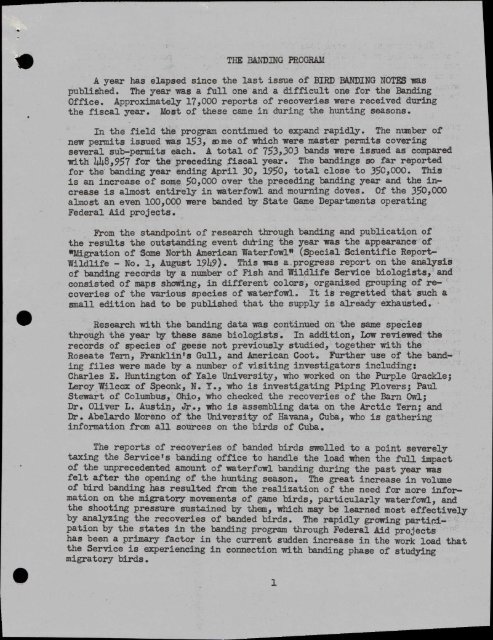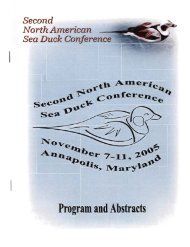BIRD BANDING NOTES - Patuxent Wildlife Research Center
BIRD BANDING NOTES - Patuxent Wildlife Research Center
BIRD BANDING NOTES - Patuxent Wildlife Research Center
You also want an ePaper? Increase the reach of your titles
YUMPU automatically turns print PDFs into web optimized ePapers that Google loves.
THE <strong>BANDING</strong> PROGRAM<br />
A year has elapsed since the last issue of <strong>BIRD</strong> <strong>BANDING</strong> <strong>NOTES</strong> was<br />
published. The year was a full one and a difficult one for the Banding<br />
Office. Approximately 17,000 reports of recoveries were received during<br />
the fiscal year. Most of these came in during the hunting seasons.<br />
In the field the program continued to expand rapidly. The number of<br />
new permits issued was 153, same of which were master permits covering<br />
several sub-permits each. A total of 753,303 bands were issued as compared<br />
with 48,957 for the preceding fiscal year. The bandings so far reported<br />
for the banding year ending April 30, 1950, total close to 350,000. This<br />
is an increase of some 50,000 over the preceding banding year and the increase<br />
is almost entirely in waterfowl and mourning doves. Of the 350,000<br />
almost an even 100,000 were banded by State Game Departments operating<br />
Federal Aid projects.<br />
From the standpoint of research through banding and publication of<br />
the results the outstanding event dui-ing the year was the appearance of<br />
"Migration of Some North American Waterfowl" (Special Scientific Report-<br />
<strong>Wildlife</strong> - No. 1, August 1949). This was a progress report on the analysis<br />
of banding records by a number of Fish and <strong>Wildlife</strong> Service biologists, and<br />
consisted of maps showing, in different colors, organized grouping of recoveries<br />
of the various species of waterfowl. It is regretted that such a<br />
small edition had to be published that the supply is already exhausted.<br />
<strong>Research</strong> with the banding data was continued on the same species<br />
through the year by these same biologists. In addition, Low reviewed the<br />
records of species of geese not previously studied, together with the<br />
Roseate Tern, Franklin's Gull, and American Coot. Further use of the banding<br />
files were made by a number of visiting investigators including:<br />
Charles E. Huntington of Yale University, who worked on the Purple Grackle;<br />
Leroy Wilcox of Speonk, N. Y., who is investigating Piping Plovers; Paul<br />
Stewart of Columbus, Ohio, who checked the recoveries of the Barn Owl;<br />
Dr. Oliver L. Austin, Jr., who is assembling data on the Arctic Tern; and<br />
Dr. Abelardo Moreno of the University of Havana, Cuba, who is gathering<br />
information from all sources on the birds of Cuba.<br />
The reports of recoveries of banded birds swelled to a point severely<br />
taxing the Service's banding office to handle the load when the full impact<br />
of the unprecedented amount of waterfowl banding during the past year was<br />
felt after the opening of the hunting season. The great increase in volume<br />
of bird banding has resulted from the realization of the need for more information<br />
on the migratory movements of game birds, particularly waterfowl, and<br />
the shooting pressure sustained by them, which may be learned most effectively<br />
by analyzing the recoveries of banded birds. The rapidly growing participation<br />
by the states in the banding program through Federal Aid projects<br />
has been a primary factor in the current sudden increase in the work load that<br />
the Service is experiencing in connection with banding phase of studying<br />
migratory birds.












